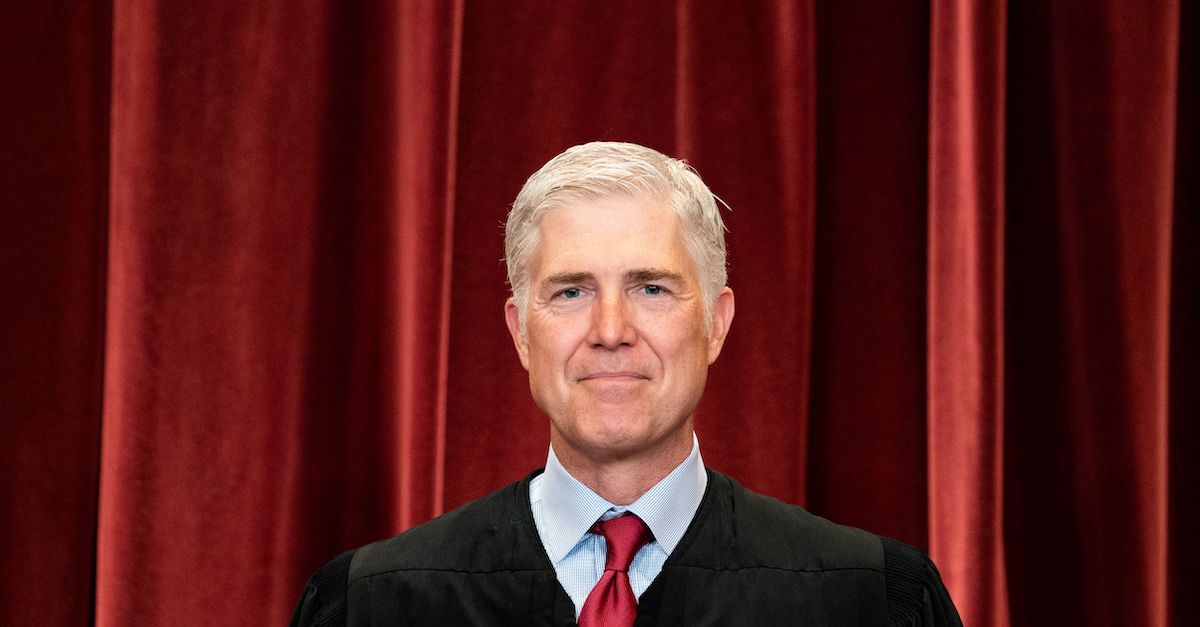
Associate Justice Neil Gorsuch stands during a group photo of the Justices at the Supreme Court in Washington, DC on April 23, 2021.
Justice Neil Gorsuch is being accused of materially misrepresenting a citation in a recent concurrence to a high court opinion that struck down the Biden administration’s vaccine-or-test mandate for certain large businesses.
The members of the court’s conservative supermajority kept their names off the decision that ruled the Occupational Safety and Health Administration (OSHA) lacked the authority to mandate a vaccination-or-testing regime for businesses under the auspices of an “Emergency Temporary Standard” (ETS) administrative regulation. Gorsuch, however, issued a concurrence that allowed himself — as well as Justices Clarence Thomas and Samuel Alito — to stand up and be counted as fierce opponents of the since-scuttled plan. But the concurrence relies on a significant misrepresentation of an argument in a prior brief issued by the workplace safety agency itself.
The concurrence reads, with the citation intact (emphasis ours):
As the agency itself explained to a federal court less than two years ago, the statute does “not authorize OSHA to issue sweeping health standards” that affect workers’ lives outside the workplace. Brief for Department of Labor, In re: AFL–CIO, No. 20–1158, pp. 3, 33 (CADC 2020). Yet that is precisely what the agency seeks to do now—regulate not just what happens inside the workplace but induce individuals to undertake a medical procedure that affects their lives outside the workplace.
And here’s where that citation leads the reader (again, emphasis ours):
As explained in OSHA’s Denial Letter, AFL-CIO has not provided compelling evidence that an undefined category of “infectious diseases” pose a grave and urgent threat to workers. The OSH Act does not authorize OSHA to issue sweeping health standards to address entire classes of known and unknown infectious diseases on an emergency basis without notice and comment.
Gorsuch did not enclose the italicized material from the original source brief in quotation marks when crafting his own concurrence. However, he attempted to summarize it — and he did so by morphing it beyond its original meaning. OSHA was arguing in 2020 that it couldn’t pass certain health standards through emergency rulemaking mechanisms. Gorsuch claimed OSHA was arguing that it couldn’t promulgate medical regulations that affect people outside work in any fashion whatsoever. The two are not the same. Gorsuch’s twist (and it’s unclear if it was intentional) is akin to a straw-man logical fallacy when examined closely.
Ironically, despite Gorsuch’s mischaracterization, the 2020 OSHA brief did argue a position that was in line with last week’s majority holding — but it did not argue so broad a position as Gorsuch claimed. Buried in that thicket are distinctions between emergency rulemaking procedures and more common notice-and-comment rulemaking procedures used by administrative agencies daily. OSHA said it could not use the latter to effectuate infectious disease regulations; it ultimately attempted to do so.
In May 2020, OSHA Associate Solicitor Edmund C. Baird argued against organized labor’s effort to force the agency into issuing a COVID-19 vaccine mandate using the ETS method — as well as an even broader mandate to regulate infectious diseases generally. The agency, of course, after President Joe Biden was elected, changed course with regard to COVID-19. But their prior argument was largely about the broadness of what the AFL-CIO wanted at the time.
Gorsuch might have scored a legitimate point by lambasting OHSA for the apparent flip flop on its emergency rulemaking powers; however, rather, he mischaracterized the argument. The agency’s 2020 argument decidedly had nothing to do with, in Gorsuch’s words, “workers’ lives outside the workplace.”
Los Angeles County Deputy District Attorney Patrick Frey, who blogs and tweets under the name Patterico, spotted and explained the error in detail on his blog.
Here’s how Frey put it [emphasis in original]:
Contrary to Justice Gorsuch’s fictional paraphrasing of OSHA’s position, none of this even remotely concerns the issue of whether the “sweeping health standards” (to use Gorsuch’s phrase) “affect workers’ lives outside the workplace.” Not only is that not what OSHA said, there is no plausible construction of that language by which a reasonable reader could even argue that OSHA said what Justice Gorsuch claims they said. Justice Gorsuch’s characterization is pure fiction, with literally no basis in OSHA’s brief, whatsoever.
I’m not going to say Justice Gorsuch “made this up,” or that he is “lying.” Again: I am a constitutional conservative who has considerable respect for Justice Gorsuch — and in any event, I try not to call people liars unless the evidence of intentional dishonesty is very clear.
I will say, however, that Justice Gorsuch’s characterization of OSHA’s position is an error. It is not just inaccurate; it is a mistake at best. Again, this is not a debatable point. Justice Gorsuch might personally believe that the Occupational Safety and Health Act does not authorize OSHA to issue standards that affect workers’ lives outside the workplace. But he has no basis whatsoever for attributing that view to OSHA, based on the brief they filed in the D.C.Circuit in 2020.
Supreme Court errors are not uncommon. In October 2020, Justice Kavanaugh made an incorrect claim about Vermont’s voting laws that prompted the Green Mountain state’s top voting official to issue an open letter asking for a correction. But even after that error was conceded, Vermont was none-too-pleased.
Law&Crime reached out to Baird, the attorney who wrote the citation misrepresented by Gorsuch in the OSHA opinion concurrence, but no response was immediately forthcoming at the time of publication.
[image via ERIN SCHAFF/POOL/AFP via Getty Images]